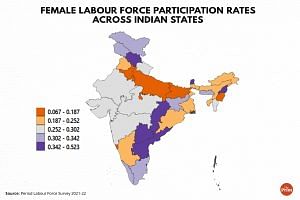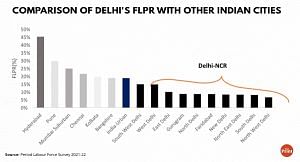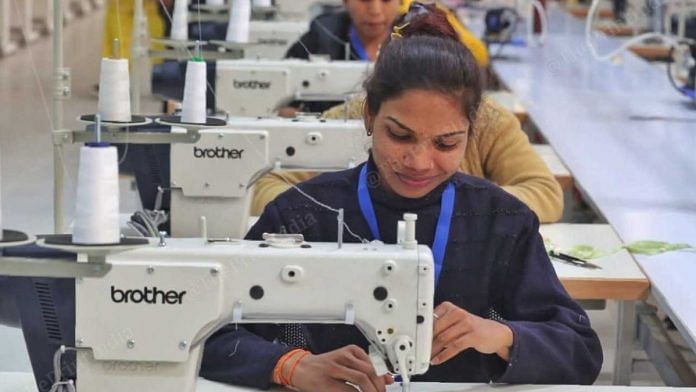At the 2014 G20 summit in Australia, world leaders committed to reduce the gender gap in labour participation by 25 per cent by 2025. With India’s G20 presidency this year, the focus on women’s role in the economy has returned considering India has been at the forefront of reducing the gender gap.
The latest Periodic Labour Force Survey (PLFS) data documents an increase in the female labour force participation rate (FLPR) from 17.4 per cent in FY18 to 24.8 per cent in FY22. While this is an overall improvement, there exists a stark divergence across states in India. A state-wise analysis of the FLPR provides some interesting insights.
Hills at the top, plains laggard
Himachal Pradesh leads with 52 per cent FLPR, while Bihar is the worst performer with 7 per cent. States along the Indo-Gangetic Plain, from Punjab to West Bengal, perform poorly on this front, while those near the eastern coast, particularly southern states such as Telangana, Andhra Pradesh, and Tamil Nadu have done relatively well. Several socio-economic factors could be instead responsible for this including literacy rates, freedom to make personal and professional choices, and asset ownership, among others.

All states (except Jharkhand) within the Indo-Gangetic Plain have a skewed sex ratio, with an average of 927 females per 1,000 males across the region. In contrast, all states (except Odisha) near the eastern coast have a favourable sex ratio with an average of 1,015 females per 1,000 males across the region. It implies that existing gender biases could also explain the variation in female labour participation across these regions.
Also read:
The national capital paradox
The National Capital Region (NCR) is regarded as “a city of opportunities”. But it is no beacon of socio-economic progress. It appears to be a sore laggard in terms of gender inclusiveness in its economy.
The survey data from the PLFS shows that Delhi has the second lowest FLPR in India after Bihar, with less than 1 in 11 women being part of the labour force. While most of the states in India have recorded an increase in their FLPR between 2017-18 and 2021-22, Delhi has witnessed a decline from 11% to 9% during the same period.
Since 97% of its population resides in urban areas, we compare the trend of FLPR in Delhi with other urban districts/cities of India. The FLPR for Delhi-NCR is not only lower than the country’s average in urban areas (18.8%), but also among the lowest compared to other metropolitan cites in the country including Mumbai, Chennai and Kolkata, which record an FLPR of 25 percent, 21 percent and 20 percent respectively.

Also read: There’s a hidden ‘pink tax’ on women’s mobility in Mumbai: Study
Why are women in Delhi not entering the labour force?
It is plausible that cultural and social factors are responsible for fewer women entering the labour force in Delhi. It is also possible that women are simply not taking up jobs due to a lack of suitable job opportunities. All of these factors may be work at the same time to an extent. We analysed the data to see which of these explanations could be the best suited for Delhi’s low FLPR rate. First, let’s study the supply side factors. On the supply side, to proxy cultural factors, we compare Delhi’s sex ratio and its female literacy levels to Mumbai, Chennai and Kolkata. We find that Delhi’s sex ratio (891 females per 1000 males) is significantly lower than the average sex ratio (953 females per 1000 males) of the other three cities. Delhi’s female literacy rate of 79 percent is also lower than the average of 88 percent for the other three cities. Therefore, a surface level analysis will show that conservative societal and cultural norms are restraining the FLPR in Delhi.
On the demand side, the data suggests that Delhi may in fact have a lower bias against woman in salaried jobs compared to Mumbai, Kolkata, and Chennai. This is evident from the fact that 83 percent of the women working in Delhi have regular salaried jobs compared to 75 percent in the other cities. A wage comparison across cities further shows that, on average, a regular salaried women worker in Delhi earns 40 percent more than her counterpart in other three metropolitan cities.
Looking at the industry-wise employment, we find that one-third of the total jobs in Delhi are in low-paying industries such as household services, retail services, and apparel manufacturing. In other metropolitan cities a quarter of the jobs are concentrated in these industries. These low-paying industries account for 26 percent of female employment share in Delhi while they account for 38 percent in the other three cities. High-paying service industries like education and civil services account for only 10 percent of total jobs in Delhi and 6 percent in other three cities.
Interestingly, these industries account for 30 percent of female employment share in Delhi, and only 10 percent in other cities. This suggests that more women in Delhi are able to bag high-paying scarce jobs than women in the other cities. As women in Delhi are engaged in better quality jobs, it could also explain why they are better paid as compared to the other three cities. It can thus be argued that there may be insufficient job opportunities in high paying industries relative to the relatively higher number of qualified women in Delhi, which is, therefore, keeping more of them out of the labour force, leading to the low FLPR.
It would have been possible to say so conclusively if data on the total number of job openings was available. But as this is not the case, it is difficult to pin point the leading cause explaining the low FLPR in Delhi from among the possible demand and supply side factors. We tend to lean towards the demand side factors as leading cause of this predicament.
However, irrespective of the exact cause, the job for the policymakers is clear-cut. Delhi needs the foster the conditions in which more and more job openings can come up for highly educated women. It also needs to start addressing social and patriarchal norms and modernise mindsets
Havishaye Puri and Cledwyn Fernandez work at the Indian Council for Research on International Economic Relations (ICRIER), a public policy think tank in New Delhi. Views are personal.
(Edited by Humra Laeeq)



